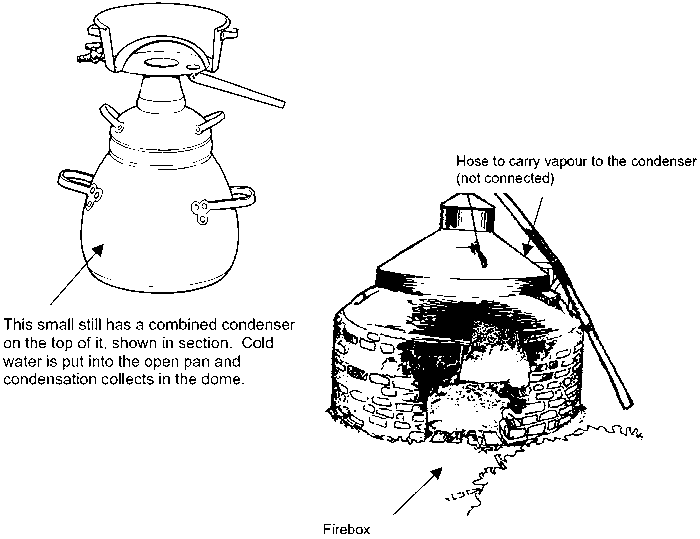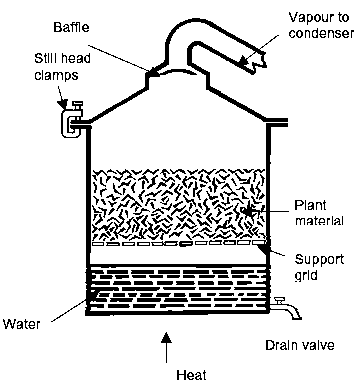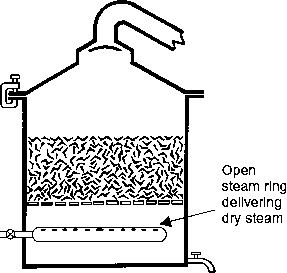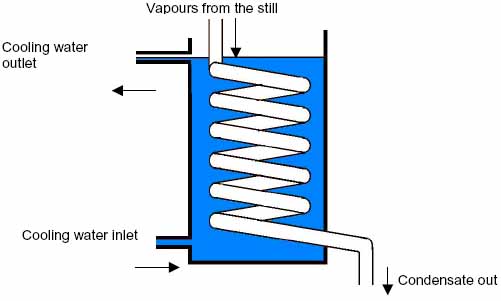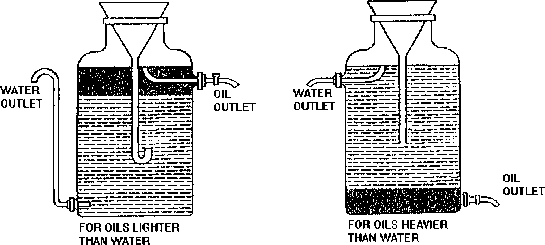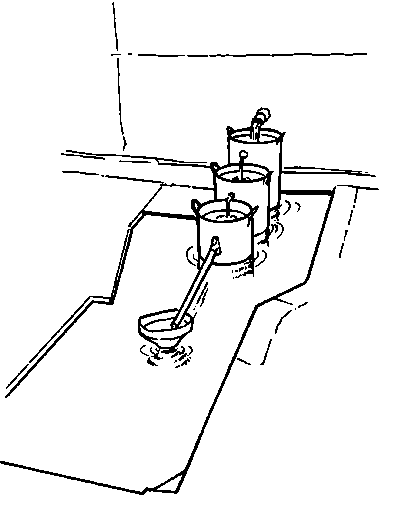Comment produire des huiles essentielles : Différence entre versions
| Ligne 174 : | Ligne 174 : | ||
• Les épices doivent être récoltées correctement et au bon stade de maturité. Le principal obstacle à la récolte correcte est la culture cueillie lorsqu'elle est immature. Cela est généralement dû à la crainte de vol ou lorsque l'agriculteur a un besoin d'argent urgent. | • Les épices doivent être récoltées correctement et au bon stade de maturité. Le principal obstacle à la récolte correcte est la culture cueillie lorsqu'elle est immature. Cela est généralement dû à la crainte de vol ou lorsque l'agriculteur a un besoin d'argent urgent. | ||
<br /> | <br /> | ||
| − | • ''' | + | • Les '''fleurs''' comme l'ylang-ylang, doivent être cueillies avec soin et traitées dès que possible. |
| − | |||
</blockquote> | </blockquote> | ||
Version du 21 août 2013 à 17:17
Sommaire
Huiles essentielles
Description brève
- Problème: extraction des huiles de différentes plantes, et fruits pour principales utilisations de parfum, de peinture, etc.
- Type d'information: application
- Difficulté: moyenne
- Combien de personnes? Jusqu'à cinq personnes
Production à petite échelle
Les huiles essentielles sont des huiles volatiles distillées à la vapeur à partir de matières végétales et représentent la saveur et l'arôme typique d'une plante particulière. On les trouve dans les fleurs, feuilles, racines, graines et écorces et elles sont utilisées principalement en parfumerie et pour créer des arômes. La teneur en huile essentielle de la matière végétale est faible, typiquement de 1 à 3% du poids de la plante. Ces produits ont une valeur très élevée, pour un faible volume. Ce qui les rend attrayants pour les petits exploitants des cultures éloignées où les coûts de transport sont élevés et empêchent le transport des cultures de moindre valeur.
Les huiles essentielles contiennent un mélange complexe de composants et c'est ce mélange qui donne la «note» que les experts reconnaissent. Le tableau 1 présente les constituants importants de certaines huiles essentielles communes.
Tableau 1 - Les huiles essentielles
|
Nom |
Partie de la plante utilisée |
Nom botanique |
Constituants importants |
Utilisations |
|
Citronelle |
Feuille |
Cymbopogon spp |
Citral |
Parfumerie |
|
Eucalyptus |
Feuille |
Eucalyptus globulus |
Cineale |
. |
|
Feuille de cannelle |
Feuil |
Cinnamomum zeylanicum |
Eugenol |
Utilisé pour produire de la vanille artificielle |
|
Clou de girofle |
Bourgeon |
Eugenia caryophyllus |
Eugenol |
Dentisterie |
|
Turpentine |
Pinus spp |
Terpènes |
Peintures | |
|
Lavende |
Fleur |
Lavendula intermedia |
Linalol |
Parfumerie |
|
Santal |
Bois |
Santalum album |
Sanatols |
Parfumerie |
|
Muscade |
Noix |
Myristica fragrans |
Myristicin |
. |
|
Amande |
Noix |
Prunis communis |
Benzaldehyde |
. |
|
Coriande |
Graine |
Coriandrum sativum |
Linalol
|
. |
La qualité de l'huile obtenue d'une espèce particulière sera influencée selon le lieu où elle est cultivée et comment elle est traitée. Les nouveaux producteurs sont susceptibles de répondre à la résistance des acheteurs, car c'est un marché très conservateur fondé dans une large mesure sur la confiance en ce qui concerne l'offre et la qualité. Les producteurs et les acheteurs aussi gardent étroitement l'information et leurs «secrets». Des marchés fiables peuvent se concrétiser, une fois les relations commerciales établies.
Les huiles essentielles sont divisées en deux grandes catégories:
• les huiles de gros volume qui sont habituellement distillées à partir des feuilles comme l'herbe de citron, la citronnelle et les feuilles de cannelle. Les huiles de citron, de lime et d'orange sont également produites en très grandes quantités.
• Les huiles de faible volume qui sont habituellement distillées à partir de fruits, de graines, de bourgeons et, dans une moindre mesure, de fleurs, par exemple, de clous de girofle, de noix de muscade, de coriandre, de vétiver et d'huiles de fleurs.
Récolte
Une bonne récolte est très importante. La teneur en huiles essentielles varie considérablement au cours du développement de la plante et selon l'heure de la journée. Si la plante est récoltée au mauvais moment, cela peut réduire le rendement en huile ou sa qualité.
Les huiles essentielles sont généralement contenues dans les glandes sébacées ou dans des veines fragiles. Une mauvaise manipulation peut briser ces structures et libérer les huiles entraînant des pertes. C'est la raison pour laquelle une forte odeur se dégage lorsque ces plantes sont traitées. Quelques exemples de la récolte des huiles courantes sont les suivantes:
• La citronnelle. La première récolte peut avoir lieu 6-9 mois après la plantation. Ensuite, l'herbe peut ensuite être récoltée jusqu'à quatre fois par an. Si récoltée trop souvent, la productivité de l'usine sera réduite et la plante peut même en mourir. Si on laisse la plante devenir trop volumineuse, le rendement en huile est réduit. Pour la citronnelle, elle devrait avoir une hauteur de 1,2 m avec 4-5 feuilles. L'herbe doit être récoltée tôt le matin tant qu'il ne pleut pas. La récolte peut se faire avec des machettes ou des couteaux simples.
• L'écorce de cannelle est récoltée pendant la saison des pluies pour faciliter le pelage de l'écorce. La récolte consiste en l'ablation de l'écorce des tiges de 1.2-5 cm de diamètre. Ceci a lieu tôt dans la matinée.
• Les épices doivent être récoltées correctement et au bon stade de maturité. Le principal obstacle à la récolte correcte est la culture cueillie lorsqu'elle est immature. Cela est généralement dû à la crainte de vol ou lorsque l'agriculteur a un besoin d'argent urgent.
• Les fleurs comme l'ylang-ylang, doivent être cueillies avec soin et traitées dès que possible.
The preparation of the material for distillation varies. Some materials, and in particular flowers, should be distilled as quickly as possible. Many herbs are left to wilt, or are dried before distillation while barks, seeds and roots can be dried and stored for several months prior to distillation. Information on small scale drying systems can be found in the Practical Action Technical Briefs on drying.
As oil is lost during drying care needs to be taken and low temperatures used. Allowing leaves to dry in the shade or partial shade will result in less loss than direct sun drying. It is vital that the material is dried to a moisture content that is low enough to prevent the growth of moulds and typical moisture levels are shown in Table 2. The dried product should be stored in a cool place and protected from any pick-up of moisture.
Table 2: moisture contents for various spices
|
Spice |
Maximum final moisture |
|
Mace |
6.0 |
|
Nutmeg, cloves |
8.0 |
|
Turmeric, coriander |
9.0 |
|
Cinnamon |
11.0 |
|
Pepper, pimento, chillies, ginger |
12.0 |
|
Cardamom |
13.0 |
Distillation
This section examines the three common methods of distilling essential oils first examining the stills used and then condensers and oil separation methods.
• Water distillation is the simplest and cheapest distillation method. Two stills are shown in Figure 1 below.
The plant material is totally immersed in water and boiled. The steam and oil vapour is condensed and the oil is separated from the water using the system described below. The stills used are simple and find wide use amongst smallholder farmers, They are often heated over an open fire, which if not carefully controlled, may result in local overheating and burning of the charge. The quality of the oils produced in such traditional stills can be improved if they are heated by steam generated in a separate boiler. This, however, requires more expenditure in capital equipment. Water distillation remains the recommended method for barks, such as cinnamon and sandlewood, and certain flowers.
• Water-steam distillation is an improvement of simple water distillation. The charge of plant material is supported on a mesh or grill above boiling water as shown in Figure 2. The water is boiled, either over a fire or by steam from a boiler using a steam coil or jacket. This system greatly reduces local overheating and burning of the charge. It is important that the charge is packed evenly and not too tightly into the still. Over-packing will result in back-pressure and the steam finding channels through the charge leaving zones that have not been extracted.
• Steam distillation is the most advanced method and depends on live steam being supplied from an external boiler. The charge is again supported on a mesh above the base of the still and above a steam coil as shown in Figure 3.
The principle advantage of this method is that “dry steam” is used which results in reduced distillation times and hence greater outputs.
All still bodies should be insulated to reduce heat losses and fuel consumption. In some cases they are mounted on frames that allow them to be inverted in order to rapidly remove the hot charge after distillation. This reduces “turn round times” and increases daily outputs.
Modern still bodies are usually made from stainless steel while traditional systems use mild steel. For the reasons described below, in many cases, the use of expensive stainless steel is not necessary.
Condensers
Steam containing the essential oil vapour leaves the still via a head, known as a gooseneck, and passes to a condenser as shown in Figure 4. Simple condensers consist of a metal coil in a tank of flowing cold water. Ideally the coil of the condenser should be constructed from an inert material such as stainless steel in order to prevent the oil chemically reacting with mild steel. In many traditional stills the gooseneck and condenser coil were constructed from copper or brass that had been internally tinned to provide a reasonably inert surface. It is very important that the condensed steam (water) leaving the condenser is thoroughly cooled. If it is still warm there will be a loss of essential oil.
Oil separation
The final step in the distillation of essential oils is the separation from the water flowing from the condenser using a special flask called a Florentine. This is a very important stage as small quantities of oils of very high value are being handled and maximum efficiency is the key to profitability.
Most essential oils are lighter than water and float to the surface of the Florentine. Some oils, however, are denser than water and sink to the bottom. For this reason two types of Florentine are used as shown in Figure 5. It is common practice to link several Florentines together. Most of the oil will separate in the first flask but some will pass over with the water to the second, third etc. separates the oil from the water. This is usually done by letting the mixture settle in a large container made of glass. If the oil is heavier than water, the oil is collected from the bottom of the container, and if lighter from the top.
Using a sequence of oil separators will extract a greater amount of oil.
If the water is cloudy after separation, it should be returned to the distillation unit and redistilled. This is called 'cohabitation'.
At the end of the distillation the oil and water in the Florentines is placed in a large laboratory separating funnel (Figure 6) and allowed stand for several hours after which the water can be run off. At is stage a small plug of cotton wool is often placed in the outlet of the funnel. As the oil runs through the plug any final traces of water are removed.
The oil should be stored in brown glass bottles or drums, tightly closed and with the minimum possible headspace as oxygen in the air reacts with many oils.
References and further reading
Minor Oil Crops FAO Agricultural Services Bulletin 94, B. Axtell, FAO,1992
Essential oil distillation Food chain No 24, ITDG, 1999
Quality Control of Essential Oils: Series on Aromatic Plants of Sri Lanka Booklet No 4,
Ceylon Institute of Scientific & Industrial Research (CISIR), 1981
This Howtopedia entry was derived from the Practical Action Technical Brief Essential Oils.
To look at the original document follow this link:
http://www.practicalaction.org/?id=technical_briefs_misc
Useful addresses
CISIR is now called the Industrial Technology Institute (ITI)
ITI
363 Bauddhaloka Mawatha
Colombia 7
Tel: +94 (1)698 624 /697 994
Fax: +94 (1) 698 624/697
E-mail: info@iti.lk
Website: http://www.iti.il
Practical Action
The Schumacher Centre for Technology & Development, Bourton on Dunsmore, RUGBY, CV23 9QZ, United Kingdom.
Tel.: +44 (0) 1926 634400, Fax: +44 (0) 1926 634401
e-mail: practicalaction@practicalaction.org.uk
web: www.practicalaction.org

Equipment suppliers
Please note this is a selective list of suppliers and does not imply endorsement by Practical Action.
Macanuda, Divisão de Máquinase Equipamantos
Rua Araranguá, 41
Bairro América - Joinville - SC
Brazil
Tel/Fax: +47 422 6706
E-mail: macanuda@ig.com.br
Website: http://www.macanuda.hpg.ig.com.br
Manufacture distillation equipment with capacities from 30 litres to 900 litres.
Newhouse Manufacturing Co., Inc.
1048 North Sixth Street
Redmond, OR 97756
USA
Tel: +1 541 548 1055,
E-mail: info@newhouse.mfg.com
John Dore & Co. Ltd
282 Chessington Road, Ewell
Epsom, Surrey, KT19 9XG
United Kingdom
Tel: + 44 (0)20 83931629
Fax: + 44 (0)20 87867627
Website: http://www.johndore.co.uk
John Dore & Co. Ltd supplies copper and stainless steel fabrications comprising: distillation plant for potable alcohol, essential oil stills, water stills, caramel pans, tanks and heat exchangers.
Sté de Fabrication Alambics Armagnacais et Charentais (SOFAC)
Z.I. Route de Nérac
32100 Condom
France
Tel: + 33 5 62 28 00 13
Fax: + 33 5 62 28 36 51
Manufacture distillation still for essential oils and alcohol.
Chemac Equipments PVT Ltd.
M.J.D'Souza Compound, Saphed Pool, Saki Naka, Mumbai - 400 072
India
Tel: +91 (0)22 2851 0777 / 859 2352.
Fax: +91 (0)22 2851 6986
Website: http://www.chemacequipments.com/
As an agency concerned with support to people in the developing countries, we do not in fact manufacture or sell equipment. Steam Distillation Units with a throughput of 50 litres up to 200
Alvan Blanch
Chelworth
Malmesbury
Wiltshire
SN16 9SG
United Kingdom
Tel: +44 (0) 666 577333
Fax: +44 (0) 666 577339
E-mail: info@alvanblanch.co.uk
Website: http://www.alvanblanch.co.uk
Essential Oil Distillation Plant used to extract oil from a variety of crops, herbs and spices using the method of distillation. Capacity: 130-420 kg/hour.
Related Articles
- How to Produce Essential Oils
- How to Process Oilseed on a Small Scale
- How to Process Spice
- How to Process Turmeric
- How to Process Ginger
- How to Process Cumin
- How to Process Cinnamon
- How to Process Pepper
- How to Process Nutmeg and Mace
- What to Do with Vetiver
Soutenez le travail d’Howtopedia, aidez-nous à continuer à écrire et à traduire plus d'articles pratiques sur des technologies simples!
<paypal />
